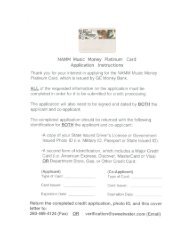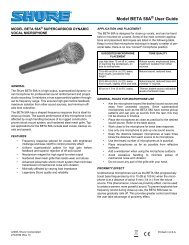Create successful ePaper yourself
Turn your PDF publications into a flip-book with our unique Google optimized e-Paper software.
Performance Functions and Effects<br />
Editing a Tone<br />
You can turn the ANALOG MODIFY knobs to edit the currently<br />
selected Tone (including rhythm set Tones).<br />
For details on using ANALOG MODIFY, refer to “Modifying<br />
the Sound (ANALOG MODIFY)” (p. 37).<br />
The Tone settings you edit are stored in the Performance (p.<br />
41).<br />
The current Tone is the Tone at whose Tone number the cursor<br />
is located in the screen when you press [TONE].<br />
Editing a Tone in detail<br />
You can edit the currently selected Tone (including rhythm set<br />
Tones) in more detail. The Tone settings you edit are stored in<br />
the Performance (p. 38).<br />
1. Press [MENU].<br />
Parameter Value Explanation<br />
Attack Time -64–+63<br />
Decay Time -64–+63<br />
Release<br />
Time<br />
Vibrato<br />
Rate<br />
Vibrato<br />
Depth<br />
-64–+63<br />
-64–+63<br />
-64–+63<br />
The same as ATTACK described<br />
in page 38.<br />
Adjusts the decay time (the time<br />
from when the attack has<br />
finished until the volume reaches<br />
the level at which it will remain<br />
as long as you hold down the<br />
key). Higher settings produce a<br />
longer decay time.<br />
The same as RELEASE described<br />
in page 38.<br />
Adjusts the modulation speed of<br />
vibrato. Higher settings produce<br />
faster vibrato.<br />
Adjusts the modulation depth<br />
vibrato. Higher settings produce<br />
more intense vibrato.<br />
2. Use [ ] [ ] to select “Perform Tone Edit” then press<br />
[ENTER].<br />
Vibrato<br />
Delay<br />
-64–+63<br />
Adjusts the time until vibrato begins.<br />
Higher settings produce a longer<br />
delay until vibrato will begin.<br />
3. Use [ ] [ ] to select the Upper or Lower Tone that<br />
you want to edit.<br />
4. Use [ ] [ ] to select a parameter, and turn the VALUE<br />
dial to adjust the value.<br />
5. When you’ve finished making settings, press [EXIT].<br />
The Main screen will appear.<br />
Mono/Poly<br />
MONO<br />
POLY<br />
TONE<br />
Only the last-played note will<br />
sound. This setting is effective<br />
when playing a solo instrument<br />
patch such as sax or flute.<br />
Two or more notes can be<br />
played simultaneously.<br />
Uses the Tone’s Mono/Poly setting.<br />
Tone Parameters<br />
Parameter Value Explanation<br />
Level 0–127 Adjusts the volume of the Tone.<br />
Pan<br />
Chorus<br />
Send Level<br />
Reverb<br />
Send Level<br />
L64–0–<br />
R63<br />
0–127<br />
0–127<br />
Cutoff -64–+63<br />
Adjusts the panning (left/right<br />
stereo position) of the Tone.<br />
Values beginning with “L” place<br />
the sound at the left, 0 at the<br />
center, and “R” at the right.<br />
Level of the signal sent to<br />
Chorus.<br />
Level of the signal sent to<br />
Reverb.<br />
The same as CUTOFF described<br />
in page 38.<br />
Legato<br />
Switch<br />
OFF,<br />
ON,<br />
TONE<br />
This setting specifies whether the<br />
Legato Switch will be used (ON)<br />
or not (OFF). Legato Switch is<br />
valid when the Mono/Poly<br />
parameter is set to “MONO.”<br />
With the Legato Switch “ON,”<br />
pressing a key while continuing<br />
to press a previous key causes<br />
the note to change pitch to the<br />
pitch of the most recently pressed<br />
key, sounding all the while. This<br />
creates a smooth transition<br />
between notes, which is effective<br />
when you wish to simulate the<br />
hammering on and pulling-off<br />
techniques used by a guitarist.<br />
When “TONE” is selected, the<br />
Tone’s own settings take effect.<br />
Resonance -64–+63<br />
The same as RESONANCE<br />
described i n page 38.<br />
40
















